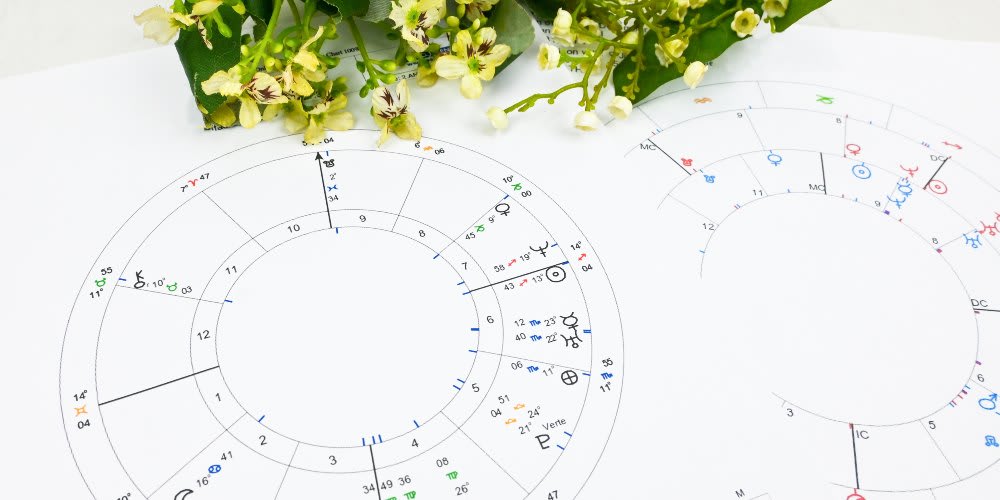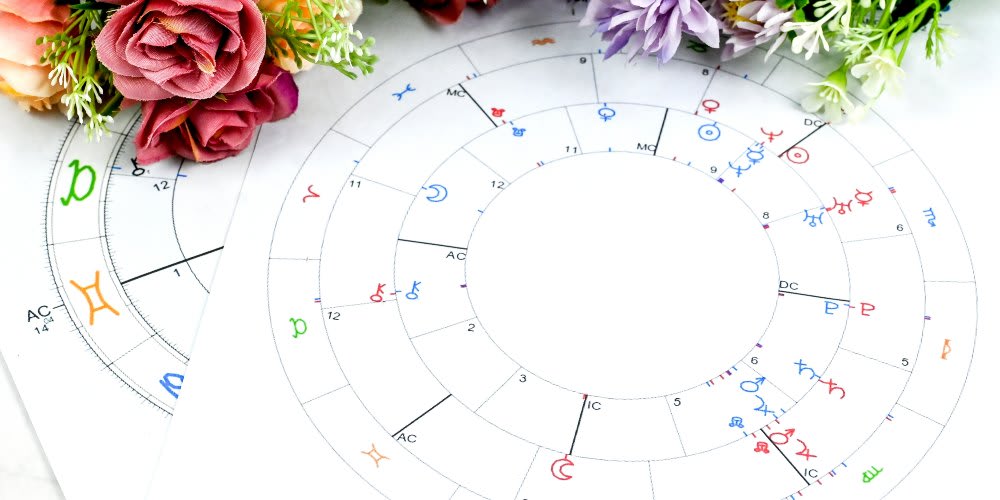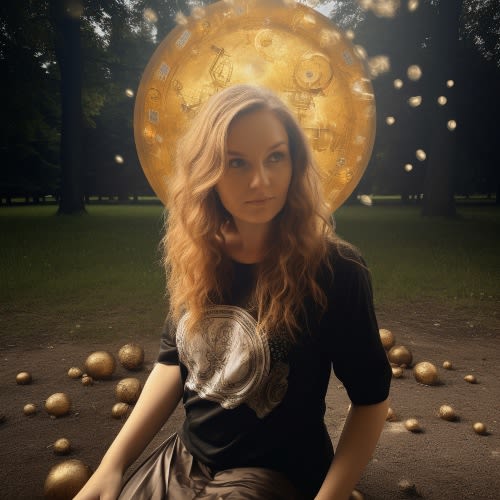Romance is a fascinating facet of human life. Astrology has long been helping to gain insight into the dynamics of personal relationships. In fact, there exists a special branch of astrology that focuses on comparing the birth charts of individuals to determine compatibility and potentially problematic areas. It is called synastry, a term derived from the Ancient Greek sunastría meaning "conjunction of the stars."
What Is The Natal Chart In Astrology?
The natal birth chart is one of the most indispensable tools in astrology, providing insight into one's personality, life path, and potentially successful relationships. It is a map of the sky at the exact moment and location of a person's birth. The map is divided into 12 sections, known as houses, each representing a different area of life: career, relationships, spirituality, and others. The locations of the planets and other celestial bodies, including the Sun and the Moon, are charted to show their placement in the zodiac signs and houses. Each planet has its own unique energy and symbolism, as well as the sign and house it is plotted in. Together, these astrological factors can influence a person's character traits, strengths, weaknesses, and life experiences and are used in determining the natal chart compatibility of individuals.
How Does Synastry Astrology Work?
By comparing people's natal charts, astrologers can assess how promising the idea of them starting a relationship is. In fact, this comparison forms the basis of synastry in astrology. The process involves analyzing the positions of the planets, the houses they fall into, and the aspects, or angles, they form with one another in one person's chart and comparing them to the other's. The astrologer looks for areas of consonance and discord, such as shared values, communication styles, and emotional needs. They also examine potential challenges, such as conflicting goals or personality clashes.
How do planets affect synastry?
By looking at the planets in the houses, synastry determines the benefits they bring or the damage they cause to the relationship. Let's consider an example. We'll take Venus, the planet of love, and Mars, representing passion and aggression. If one person's Venus is positioned at a certain angle to the other person's Mars, it can be indicative of an unquestionable chemistry. Similarly, if one person's Moon has a particular position with regard to the other person's Sun, it can indicate emotional tension and conflicting needs.
Overall, the positions and angles between the planets in the two birth charts are crucial to studying their owners' compatibility. These angles are called aspects, and we'll tell you all a beginner needs to know about them below.
What do aspects mean in synastry?
The most common exact aspects in synastry are conjunctions, oppositions, trines, squares, and sextiles. Each of them can create a rapport or create impediments and misunderstandings. For example, a conjunction can indicate a solid connection and shared energy, while a square can signify potential tension and conflict.
It's important to know that there are no best aspects in synastry, and you need to look at all markers at once to see and interpret the big picture. Let's find out what each represents and how it works.

Conjunction
Two planets in the immediate proximity of each other—at an angle of eight or so degrees—form a conjunction. This is one dominant aspect that carries tons of significance in synastry. The planets' energies combine and, consequently, get amplified.
A conjunction can have various significances depending on the types of celestial bodies entering it. When formed by personal planets, i.e., Sun, Moon, Mercury, Venus, or Mars, the conjunction attests to a stable bond and rapport. For example, if one person's Sun is conjunct another person's Moon, it suggests a keen emotional connection and understanding. If Venus is in conjunction with Mars, it can be indicative of chemistry and passion.
Conjunctions can also occur between outer planets, i.e., Jupiter, Saturn, Uranus, Neptune, and Pluto, which can point to common goals or a shared destiny. For example, if one person's Uranus is conjunct the other person's Pluto, together, they'll be able to accomplish many revolutionary things and transformations.
Conjunctions can also strengthen other aspects in the synastry chart or contradict their influence. For example, there can be tension in a relationship resulting from a square aspect between two planets. However, the same two planets can simultaneously be in conjunction with another planet, creating a tight bond between the individuals and leveling down the negative impact of the square.
That being said, it is crucial to note: not all conjunctions are positive. If malefic planets are involved, their influence can lead to struggles or conflicts. The bottom line is: it is essential to consider the overall chart and all aspects presented in it before drawing any conclusions.
Sextile
This aspect between planets occurs when they are about 60 degrees apart. Sextiles usually implicate a balanced, supportive relationship because they enable an unimpeded energy flow. The planets that form the sextile indicate the exact areas where the balance and support will mostly happen. For example, if one person's Venus—the planet associated with love— forms a sextile with another person's Mars, which is considered passionate and active, it can result in a physical attraction and natural harmony.
Sextiles can also point to the areas where growth and development will be most likely and beneficial. E.g., if one person's Saturn is sextile the other person's Sun, the latter will be the creative force of the relationship, while the former will add structure and stability to these creative outbursts.
Regardless of their being generally accepted as positive, sextiles do not just make things happen, as if by magic. Both people should expend some effort to make the relationship work and make ample use of the benefits endowed upon them by the planets.
Square
The aspect that is formed by two planets that are positioned 90 degrees apart is called a square. Unlike the sextile, the square usually creates tension and challenges. If it is present in your synastry charts, be sure that there will be certain friction or other obstacles in your relationship.
For example, if one person's Mars is square to the other person's Venus, the opposing energies of the two planets may bring about struggles. The person with Venus in their chart will be stifled by the Mars person’s assertiveness and energy, while the latter may feel underwhelmed by the Venus person’s lack fo drive.
Squares in synastry put people at odds or force them to struggle to find common ground. But this struggle can ultimately drive both individuals to embrace their differences, grow and learn to compromise, which is not at all a bad thing.
Trine
Two planets positioned at 120 degrees to each other enter a trine—a favorable aspect that promotes an uninhibited flow of energy, thus enhancing compatibility, understanding, and relationship as a whole. Suppose one person's loving Venus forms a trine with another person's passion-driven Mars. In that case, their relationship may have strong physical attraction and a shared sense of pleasure.
However, multiple trines in a synastry chart can indicate a lack of good challenge that leads to growth. A relationship will only evolve and deepen if it has some tension to it.
Opposition
Last but not least, the opposition is an aspect that involves a 180-degree angle between two planets. This positioning inhibits energy flow, leading to friction and conflict. For example, if one person's Mars is in opposition to the other person's Venus, there may be a struggle to balance assertiveness and aggression with love and harmony in the relationship. However, this struggle can be resolved through compromise—if both partners are willing to resort to it.
Not all oppositions are counterproductive, though. Some are indicative of passion, e.g., one person's Sun being in opposition to the other person's Moon. This aspect points to a strong emotional connection and chemistry but can cause miscommunications and misunderstandings due to the overall intensity of the situation.

Birth Chart Houses Synastry: What Is The Relationship?
Studying a birth chart with houses can be crucial in determining an individual's compatibility with another person. As houses basically stand for different areas of life, when planets from one person's chart end up in another person's houses, it can designate a presence or absence of a connection in this area of life. E.g., if one person's Venus falls into the other person's 7th House of Partnerships, it can be a sign of great romantic potential. Quite conversely, the relationship will be ridden with conflict if one person's Mars falls into the other person's 12th House of the Subconscious, which is responsible for all things unseen.
Another crucial thing to consider while analyzing birth charts is the rulers of each house and their interactions. Let's take the 5th House of Creativity as an example: if it is ruled by the Sun for one person and by the Moon for the other, their connection can be substantial because they will share numerous interests and creative endeavors.
A Brief Summary
So is synastry a branch of astrology that you should reckon with? The answer is definitely yes. It is a powerful tool that can take you to a whole new level of interpreting the dynamics of your relationship. Synastry can reveal the strength and weaknesses of the two of you as an item. It can help you develop your potential and improve your connection—or al least point you in the right direction.












Did you like the article?
Response
Superb
Love
Wow
Sad
Laugh
Angry